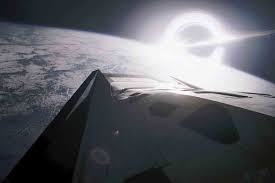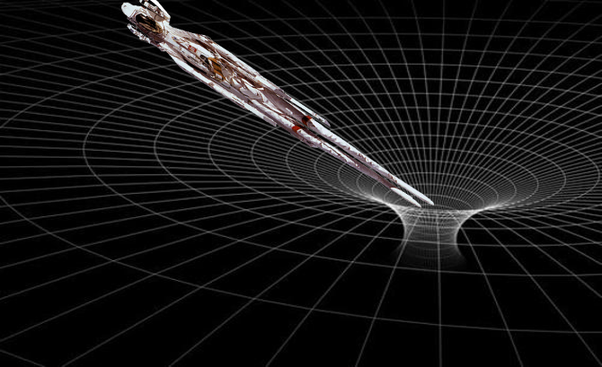Myths of modern popular physics
Somewhere in the alternate universe, according to MWI , I became a brilliant physicist. But in this universe, I simply follow in detail the professional publications in the field of physics, earning my own bread by delivering pizza databases. As a result of a little deeper knowledge, I cannot watch any popular science broadcasts. It's like iron on glass - oversimplification is here, it’s just wrong, there are subtleties ...
I decided to create a list of the most common falsehoods and half-truths. So, the most frequent is ...
He is portrayed like this:
')

Then a statement usually follows: “When the Universe was not larger than the size of an atom ...” and so on. Here the most important word is missing, which completely changes the meaning: “When the visible Universe was no more than the size of an atom ...”. The visible Universe, roughly speaking, is an area where the light could pass from one place to another from the moment t = 0. That is, a small ball that swells (approximately!) With the speed of light (actually faster). Such balls can be infinitely many.
Moreover, if the universe is infinite, then it is infinite from the very beginning. Endless and almost uniform. And this picture (and also a beautiful render with an explosion that they like to show) has nothing to do with reality. There is no point where there was an explosion that spread into the surrounding void. Again, the universe was almost homogeneous (and the farther into the past, the more homogeneous).
In addition, the Big Bang theory is NOT the big bang theory (t = 0). This is the theory of what happened after the big bang (t> 0). She does not answer the question, in particular, why this big bang happened. Yes, and the name itself - Big Bang - was initially used as a mockery of the theory , but stuck to it.
Oh, here is just the abyss (black hole) of popular myths. Let's start with Interstellar:

In order for the time dilation to be so, the planet should have been at a distance of just over 0.003% of the Schwarzschild radius. Meanwhile, judging by the appearance of a black hole:

The planet is at least 10 * Rs from the event horizon. We are not even talking about the fact that such a planet is probably the worst candidate for the planet, where it was worth flying. Of course, this is a feature film. No one judges Star Wars for the sound of explosions in space. But Star Wars never claimed to be scientific. And Interstellar - claimed, and with pathos. Therefore, there is another demand from it.
To close the topic with Interstellar, according to modern scientific data, there is also no library inside the black hole.
An interesting case of half-truths and wrong conclusions. It all begins with the correct statement: when approaching the event horizon for observers suspended above a black hole, the time dilation tends to infinity. It's right. But several myths grow out of this statement:
All these conclusions grow from the first, wrong. But it looks so believable that at the beginning of the last century it was long misleading even by professional physicists! So, we have a set of points closer and closer to the horizon, and when time approaches the horizon, it tends to infinity, and since the trajectory of a body falling into a black hole passes through all these points, then for it the time delay tends to infinity! Is it logical And no.
Time dilation is a property of a trajectory , not a point of space . What is true for an observer “suspended” at a fixed distance above the horizon is wrong for an observer falling into a black hole. Actually, for a long time even Einstein himself could not solve the equation of his own general theory of relativity for the regions inside the horizon of the black hole - everything rested on infinity on the event horizon. Progress appeared when instead of points in space they began to consider a system of "rain", freely falling inside a black hole. In this system of infinities on the horizon did not appear.
Moreover, it became clear that what was later called “No drama” - when crossing the event horizon, nothing special happens for a freely falling observer - no disturbing music, pi-pei and greenish flashes. Failure under the horizon can not even notice!
For those who want more details about what is happening inside the black hole from the “rain” point of view, I recommend reading about Eddington-Finkelstein coordinates :

They are interesting in that simply by running your finger over them, you can graphically give answers to many questions. In particular, about our myths:

The strength of our body is such that our body will begin to break in about a second in time to the singularity. Given that a free fall into a black hole almost always occurs at a speed close to the speed of light, this will happen about 300000 km before the event horizon. Given that the usual black hole, which is the remnant of a star, has a radius of 10-15-20km, it will tear us long before approaching the horizon.
However, there are supermassive black holes with a mass of billions of solar masses and a radius larger than the orbit of Uranus. In such black holes, flying from the horizon to the singularity is a clock! it is in such black holes that one can fall through without noticing it.
Again, this is true for small black holes. The radius of the event horizon is proportional to the mass. And this is quite surprising, because at constant density, the mass of the object is proportional to the cube of the radius.
The gravitational radius of the Earth is slightly less than a centimeter. Increase the radius of the Earth 10 times (leaving the density of matter is the same). Such a super-earth will be 1000 times harder. The gravitational radius, respectively, will also increase by a factor of 1000, and the volume inside the gravitational radius will increase by a billion! time. That is, 1000 times more matter, we need to cram a billion times more volume, that is, now it is necessary to compress matter a million times less.
Thus, increasing the scale of any body, we always reach the state when the gravitational radius “catches” the real one. So a black hole can be made from any material, without compressing it - from water, cotton, gas. Even from the universe with its negligible average density - the gravitational radius of the universe with its density of about 10 billion light years.
By the way, this is one of the reasons why static solutions of the Universe are impossible - it would just become a black hole. Our universe is not threatened, as it expands.
There are many more myths, if you like the article, I will continue.
I decided to create a list of the most common falsehoods and half-truths. So, the most frequent is ...
Big explosion
He is portrayed like this:
')

Then a statement usually follows: “When the Universe was not larger than the size of an atom ...” and so on. Here the most important word is missing, which completely changes the meaning: “When the visible Universe was no more than the size of an atom ...”. The visible Universe, roughly speaking, is an area where the light could pass from one place to another from the moment t = 0. That is, a small ball that swells (approximately!) With the speed of light (actually faster). Such balls can be infinitely many.
Moreover, if the universe is infinite, then it is infinite from the very beginning. Endless and almost uniform. And this picture (and also a beautiful render with an explosion that they like to show) has nothing to do with reality. There is no point where there was an explosion that spread into the surrounding void. Again, the universe was almost homogeneous (and the farther into the past, the more homogeneous).
In addition, the Big Bang theory is NOT the big bang theory (t = 0). This is the theory of what happened after the big bang (t> 0). She does not answer the question, in particular, why this big bang happened. Yes, and the name itself - Big Bang - was initially used as a mockery of the theory , but stuck to it.
Black holes
Oh, here is just the abyss (black hole) of popular myths. Let's start with Interstellar:

In order for the time dilation to be so, the planet should have been at a distance of just over 0.003% of the Schwarzschild radius. Meanwhile, judging by the appearance of a black hole:

The planet is at least 10 * Rs from the event horizon. We are not even talking about the fact that such a planet is probably the worst candidate for the planet, where it was worth flying. Of course, this is a feature film. No one judges Star Wars for the sound of explosions in space. But Star Wars never claimed to be scientific. And Interstellar - claimed, and with pathos. Therefore, there is another demand from it.
To close the topic with Interstellar, according to modern scientific data, there is also no library inside the black hole.
Time slowdown in a black hole is infinite
An interesting case of half-truths and wrong conclusions. It all begins with the correct statement: when approaching the event horizon for observers suspended above a black hole, the time dilation tends to infinity. It's right. But several myths grow out of this statement:
- The time delay for the observer falling into a black hole is endless
- Therefore, he will see the whole future of the universe - it will accelerate for him
- Falling observers and hang somewhere near the horizon - because the time for them has slowed endlessly
- You can rush after them and catch them somewhere out on the horizon, no matter how much time passes.
- Moreover, they never fall into a black hole, because it takes infinite time
- Moreover, one can even say that in reality black holes do not exist, because for their formation infinite time is needed.
All these conclusions grow from the first, wrong. But it looks so believable that at the beginning of the last century it was long misleading even by professional physicists! So, we have a set of points closer and closer to the horizon, and when time approaches the horizon, it tends to infinity, and since the trajectory of a body falling into a black hole passes through all these points, then for it the time delay tends to infinity! Is it logical And no.
Time dilation is a property of a trajectory , not a point of space . What is true for an observer “suspended” at a fixed distance above the horizon is wrong for an observer falling into a black hole. Actually, for a long time even Einstein himself could not solve the equation of his own general theory of relativity for the regions inside the horizon of the black hole - everything rested on infinity on the event horizon. Progress appeared when instead of points in space they began to consider a system of "rain", freely falling inside a black hole. In this system of infinities on the horizon did not appear.
Moreover, it became clear that what was later called “No drama” - when crossing the event horizon, nothing special happens for a freely falling observer - no disturbing music, pi-pei and greenish flashes. Failure under the horizon can not even notice!
For those who want more details about what is happening inside the black hole from the “rain” point of view, I recommend reading about Eddington-Finkelstein coordinates :

They are interesting in that simply by running your finger over them, you can graphically give answers to many questions. In particular, about our myths:
- Free observer reaches the horizon, and then the singularity very quickly (it falls almost at the speed of light). If, not reaching the horizon, he changes his mind and gives a “full back”, then in theory he will be back in theory for a very long time, and then he will have time to fully slow down.
- The falling observer sees the universe left by him a little slowed down in time and reddened. He continues to see her even inside the horizon (light falls behind him)
- Falling observers hang somewhere near the horizon - but this is a purely optical effect, the light from them is very difficult to get out
- You can rush after them, but as soon as you begin to approach the horizon, you will see that they are no longer there. If a “suspended” observer hangs near the horizon, he will inform (in a very slow voice) that your colleague has long since failed inside. Long ago - according to this observer, given that he is intelligent and corrects his observations and is aware that he is very slow in time. According to his watch this time can be very short.
- Moreover, they never fall into a black hole, because it takes infinite time - well, you understand that this is not at all
Tidal forces are tearing everyone else on the way to the black hole

The strength of our body is such that our body will begin to break in about a second in time to the singularity. Given that a free fall into a black hole almost always occurs at a speed close to the speed of light, this will happen about 300000 km before the event horizon. Given that the usual black hole, which is the remnant of a star, has a radius of 10-15-20km, it will tear us long before approaching the horizon.
However, there are supermassive black holes with a mass of billions of solar masses and a radius larger than the orbit of Uranus. In such black holes, flying from the horizon to the singularity is a clock! it is in such black holes that one can fall through without noticing it.
To get a black hole, you have to squeeze matter to a monstrous density.
Again, this is true for small black holes. The radius of the event horizon is proportional to the mass. And this is quite surprising, because at constant density, the mass of the object is proportional to the cube of the radius.
The gravitational radius of the Earth is slightly less than a centimeter. Increase the radius of the Earth 10 times (leaving the density of matter is the same). Such a super-earth will be 1000 times harder. The gravitational radius, respectively, will also increase by a factor of 1000, and the volume inside the gravitational radius will increase by a billion! time. That is, 1000 times more matter, we need to cram a billion times more volume, that is, now it is necessary to compress matter a million times less.
Thus, increasing the scale of any body, we always reach the state when the gravitational radius “catches” the real one. So a black hole can be made from any material, without compressing it - from water, cotton, gas. Even from the universe with its negligible average density - the gravitational radius of the universe with its density of about 10 billion light years.
By the way, this is one of the reasons why static solutions of the Universe are impossible - it would just become a black hole. Our universe is not threatened, as it expands.
There are many more myths, if you like the article, I will continue.
Source: https://habr.com/ru/post/442444/
All Articles